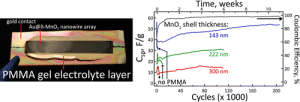
23 April 2016 – A typical Lithium-ion battery breaks down badly between 5000-7000 cycles. Researchers at the University of California may have discovered a simple way to build a Lithium battery that can withstand 100,000+ cycles. This was a serendipitous discovery as the researcher was playing around with the battery and coated it in a thin gel layer. The researchers believe the gel plasticizes the metal oxide in the battery and gives it flexibility, preventing cracking.
.Dave Gershgorn, reporting for Popular Science noted:
Instead of lithium, researchers at UC Irvine have used gold nanowires to store electricity, and have found that their system is able to far outlast traditional lithium battery construction. The Irvine team’s system cycled through 200,000 recharges without significant corrosion or decline. However, they don’t exactly know why. “We started to cycle the devices, and then realized that they weren’t going to die,” said Reginald Penner, a lead author of the paper. “We don’t understand the mechanism of that yet.” The Irvine battery technology uses a gold nanowire, no thicker than a bacterium, coated in manganese oxide and then protected by a layer of electrolyte gel. The gel interacts with the metal oxide coating to prevent corrosion. The longer the wire, the more surface area, and the more charge it can hold. Other researchers have been experimenting with nanowires for years, but the introduction of the protective gel separates UC Irvine’s work from other research.
Also from the report, Penner suggests that a more common metal, like nickel, could replace the gold if the technology catches on.